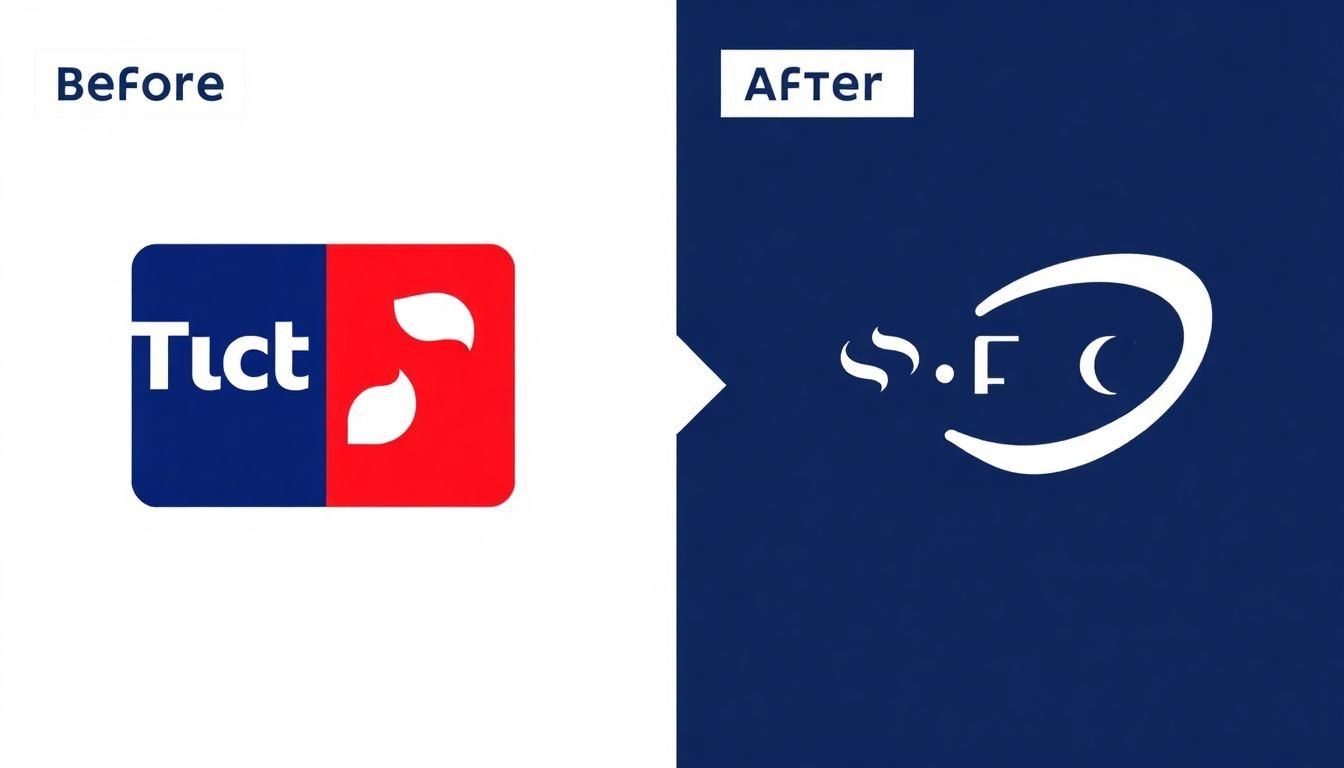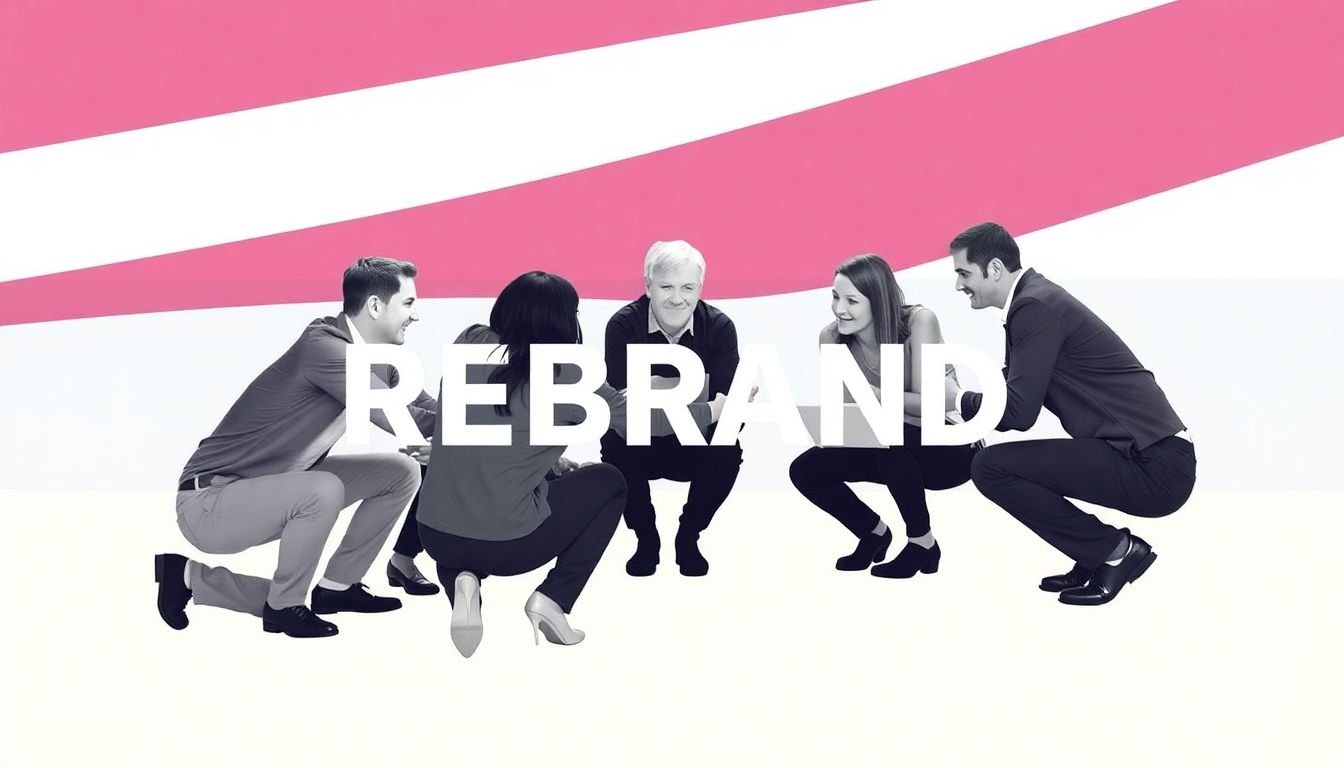
Table of Contents
In the dynamic world of business, rebranding is not just a cosmetic makeover, but a strategic move that can breathe new life into a company, realign its identity, and propel it towards uncharted growth. But with countless rebranding case studies that range from triumphant transformations to disastrous missteps, the question remains: what sets a successful brand transformation apart from the rest? Today, we delve into the art and science of rebranding done right, exploring five compelling case studies that illustrate the power of strategic rebranding.
Did you know that a well-executed rebrand can increase a company’s value by up to 21%? Yet, according to a study by Branding Strategy Insider, 77% of rebranding efforts fail to achieve their objectives. The difference between success and failure often lies in the approach, the understanding of the brand’s DNA, and the ability to connect with the audience on a deeper level.
In this article, we promise to take you on a journey through five insightful rebranding case studies, each offering a unique perspective on what makes a brand transformation successful. From the bold reimagining of a century-old company to the strategic evolution of a digital disruptor, we’ll explore the strategies, challenges, and triumphs behind these remarkable brand metamorphoses. By the end of this piece, you’ll not only be entertained by these fascinating stories but also equipped with valuable insights and practical takeaways to inspire your own brand’s transformation. So, let’s embark on this exploration of rebranding done right, where the power of a well-crafted narrative can turn a simple logo change into a brand’s rebirth.
Lessons from the Masters: A Deep Dive into Successful Brand Transformations
In the dynamic world of business, brands are not static entities but evolving organisms, capable of growth, change, and even transformation. A fascinating journey into the realm of successful brand transformations is akin to a deep dive into the ocean of corporate strategy, where we encounter the masters of their craft, the architects of these metamorphoses. These individuals, armed with vision, courage, and a profound understanding of their market, have steered their brands through tumultuous waters, emerging triumphant and rejuvenated. From the iconic rebranding of Apple under Steve Jobs to the remarkable turnaround of Nike under Phil Knight, each story is a testament to the power of innovation, adaptability, and consumer-centricity. By examining these case studies, we can unearth invaluable lessons that transcend industries and time, offering a roadmap for brands seeking to reinvent themselves in an ever-evolving business landscape. So, let us embark on this exploration, not with a critical eye, but with a curious and open mind, ready to learn from the masters and apply their wisdom to our own branding odysseys.

Understanding the Need for Rebranding
Rebranding, a strategic makeover for businesses, is not a decision taken lightly. Companies choose to rebrand for a multitude of reasons, each unique to their specific situation. Let’s delve into some of these motivations, using real-life case studies to illustrate.
Firstly, companies may rebrand to adapt to market changes. For instance, Dunkin’ Donuts, now simply Dunkin’, dropped ‘Donuts’ from its name to reflect its expanded menu and shift towards being a beverage-led company. Similarly, Diet Pepsi’s rebrand to Pepsi Max in the UK was a response to the growing demand for sugar-free alternatives.
Secondly, rebranding can be a solution to negative associations. In 2017, Philip Morris International rebranded its cigarette brand Marlboro to Marlboro HeatSticks to distance itself from the negative health implications of smoking. Likewise, KFC’s rebrand after the ‘bucket’ scandal in the UK was a way to regain consumer trust.
Timing plays a crucial role in rebranding. It’s not just about when to rebrand, but also how to time the announcement and rollout. For example, Airbnb’s rebrand to a more modern, typography-based logo was timed perfectly with their expansion into experiences and adventures, not just accommodation.
Market research is the backbone of any rebranding process. It helps understand the target audience, their perceptions, and preferences. Old Spice’s successful rebrand involved extensive market research that revealed a disconnect between the brand’s old, stuffy image and its target audience of young, adventurous men. By understanding this gap, Old Spice was able to reposition itself effectively.
In conclusion, rebranding is a complex, multifaceted process driven by various factors. It’s about understanding the need for change, timing it right, and using market research to guide the transformation. After all, a brand is a living, breathing entity, and like any living thing, it needs to evolve to stay relevant.

The Power of Storytelling: Crafting a New Narrative
In the dynamic realm of business, rebranding is often akin to turning a new page, and what better way to engage readers than with a compelling narrative? Successful rebranding campaigns have consistently harnessed the power of storytelling to forge meaningful connections with their audience. Take, for instance, Airbnb’s transformation from a simple room-rental platform to a global community of ‘Belonging’. Their storytelling didn’t just highlight features, but wove a tapestry of experiences, creating an emotional bond with users.
The importance of authenticity in this process cannot be overstated. Today’s consumers are discerning, craving genuine connections over hollow promises. A compelling brand story must ring true, resonating with the audience’s values and aspirations. Patagonia, for example, didn’t just tell a story about outdoor gear; they crafted a narrative around environmental stewardship, sustainability, and the spirit of adventure, aligning perfectly with their customers’ passions.
Crafting a compelling brand story involves several steps. First,
- understand your audience
- identify your brand’s unique essence
- define your brand’s purpose and values
Then, weave these elements into a narrative that is not only engaging but also relatable. Use vivid imagery, compelling language, and a clear arc to draw your audience in. Lastly, ensure your story is consistent across all touchpoints, from your website to your customer service.
Storytelling is not just about selling a product; it’s about creating an experience, fostering a relationship. It’s about turning customers into advocates, into storytellers themselves. So, go ahead, pick up your pen, and start crafting your brand’s new narrative. The world is waiting to be captivated.

Visual Identity: More Than Just a Logo
In the dynamic world of branding, a logo is often the first point of contact between a brand and its audience. However, a brand’s visual identity is far more than just a logo; it’s a comprehensive language that speaks volumes about the brand’s personality, values, and offerings. This is particularly evident in rebranding efforts, where a strategic overhaul of visual identity can breathe new life into a brand, making it more relevant, engaging, and memorable.
Take, for instance, the rebranding of Airbnb. The company’s original logo, the ‘ Bélo,’ was a simple, stylized heart-shaped symbol. While it was recognizable, it lacked the depth and versatility needed to represent the diverse range of experiences Airbnb offered. In 2014, Airbnb introduced a new logo, ‘The Bélo,’ which was a more intricate, geometric design that could be broken down into various components, each representing a different aspect of the Airbnb experience. This new logo, along with a vibrant color scheme and a bold, modern typography, created a visual identity that was not only more visually appealing but also more reflective of the brand’s unique value proposition.
Consistency is key in branding. A strong visual identity is not just about creating striking visuals; it’s about ensuring that these visuals are consistently applied across all touchpoints. This includes not just the logo, but also the color scheme, typography, imagery, and tone of voice. A consistent visual identity helps to build brand recognition, making it easier for customers to find and engage with the brand. It also reinforces the brand’s message, ensuring that the brand’s personality and values are consistently communicated.
Design principles play a crucial role in creating a successful visual identity. A well-designed visual identity should be simple, versatile, and timeless. It should be able to adapt to different contexts and platforms without losing its essence. It should also be memorable, standing out in a crowded marketplace while remaining true to the brand’s DNA. Above all, it should be authentic, reflecting the brand’s unique story and resonating with its target audience.
In conclusion, a brand’s visual identity is a powerful tool that can revitalize a brand, making it more relevant, engaging, and memorable. It’s more than just a logo; it’s a comprehensive language that speaks volumes about the brand. And like any language, it’s only effective if it’s used consistently and strategically.

The Role of Culture in Brand Transformation
The role of culture in brand transformation is often underestimated, yet it’s a critical factor that can make or break a rebranding effort. Successful rebranding isn’t just about a new logo or tagline; it’s about aligning the company’s identity with its culture and values. This alignment begins with engaging internal stakeholders, the employees who are the heartbeat of the organization.
Take, for instance, Airbnb’s rebranding in 2014. The company didn’t just hire a design agency to create a new logo; they involved their employees in the process. They held workshops, conducted surveys, and even created a ‘Design Challenge’ where employees could submit their own designs. This not only resulted in a logo that resonated with the company’s values but also fostered a sense of ownership and pride among the employees.
Employee engagement and buy-in are paramount in brand transformation. They are the ones who will embody the new brand, communicate it to customers, and ultimately, make it a reality. A strong company culture supports this transformation by providing a consistent framework for decision-making and behavior. It’s like a compass that guides employees through the change, ensuring everyone is rowing in the same direction.
To foster this, companies can follow these steps:
- Communicate the ‘why’ behind the rebrand. Employees need to understand the purpose and benefits of the change.
- Involve employees in the process. This could be through focus groups, surveys, or even crowdsourcing ideas.
- Provide training and resources to help employees understand and adopt the new brand.
- Lead by example. Senior leadership should be the first to embrace the new brand, setting the tone for the rest of the organization.
In conclusion, culture is the soil in which a brand takes root and grows. Nurturing this soil through employee engagement and buy-in ensures that the brand transformation is not just skin deep, but truly part of the company’s DNA.

Navigating the Launch: Communication Strategies
Navigating the Launch: Communication Strategies
In the dynamic world of branding, a rebrand is not just a visual facelift, but a strategic pivot that demands a well-orchestrated launch. Let’s explore how two case study brands, Airbnb and Tropicana, announced their rebranding to the world, highlighting both successful and unsuccessful launch tactics.
Airbnb, in 2014, unveiled its new logo, the ‘Bélo,’ with a bold, interactive launch campaign. The company employed a multi-channel approach, including social media, press releases, and a dedicated microsite. The microsite, ‘Airbnb Citizen,’ showcased the new logo’s adaptability and told the story behind the rebrand. This strategy was successful in generating buzz and sparking conversation, with the hashtag #AirbnbCitizen trending globally. However, the logo itself faced criticism for its simplicity, with some deeming it too minimalistic.
On the other hand, Tropicana’s 2009 rebrand is a classic example of an unsuccessful launch. The company replaced its iconic orange with a more abstract, futuristic design. The new packaging was rolled out without any prior announcement or explanation, leading to widespread confusion and backlash. Consumers struggled to recognize the product on shelves, and Tropicana was forced to revert to the original packaging within just two weeks. This fiasco underscores the importance of clear communication and consumer engagement during a rebrand.
In conclusion, a well-planned launch strategy is crucial for a successful rebrand. It involves clear communication, multi-channel engagement, and, most importantly, understanding and respecting the brand’s heritage and consumer base. After all, a rebrand is not just about a new logo or name; it’s about telling a new story and ensuring that the world listens.

Measuring Success: KPIs and Metrics
Measuring the success of a rebrand is a multifaceted endeavor, involving a blend of quantitative and qualitative metrics. Key Performance Indicators (KPIs) serve as our compass, guiding us through the labyrinth of data to understand the impact of a rebrand. Let’s delve into some of the most insightful KPIs, using real-world case studies to illustrate their application.
Take, for instance, Airbnb’s rebrand in 2014. The company tracked several KPIs to gauge the success of their new logo and visual identity. One of the most telling metrics was brand awareness. Airbnb measured this through surveys, tracking the percentage of respondents who recognized the new logo. Post-rebrand, this figure saw a significant increase, indicating that the new identity was resonating with their audience.
Another crucial KPI is customer engagement. This can be measured through various channels, such as social media, website traffic, and email open rates. For example, following Mastercard’s rebrand in 2019, they saw a 25% increase in social media engagement. This KPI not only reflects the success of the rebrand but also provides valuable insights into customer sentiment and behavior.
Market share is another vital metric, particularly for businesses operating in competitive markets. After rebranding, companies should monitor their market share to understand if the rebrand has helped them gain or maintain their position. For instance, when Dunkin’ Donuts rebranded as simply ‘Dunkin’ in 2019, they saw a 2.4% increase in U.S. market share within a year.
Lastly, financial performance metrics, such as revenue growth and profit margins, provide a holistic view of the rebrand’s success. While these metrics may not directly attribute to the rebrand, they reflect the overall health of the business and can indicate if the rebrand has contributed to its growth.
In conclusion, KPIs are not one-size-fits-all. Each business should select metrics that align with their rebranding objectives and provide actionable insights. By tracking these KPIs, businesses can make data-driven decisions, guiding their future branding strategies and ensuring they continue to resonate with their audience.

Lessons Learned: Common Pitfalls and How to Avoid Them
Rebranding, when executed successfully, can breathe new life into a business, refreshing its image and appealing to a wider audience. However, the road to rebranding success is paved with potential pitfalls. Let’s delve into some common missteps and learn from them.
Take, for instance, the case of Tropicana. In 2009, the company decided to modernize its packaging, replacing its iconic orange with a more abstract, futuristic design. Consumers, however, were not ready for this drastic change. They missed the familiar, friendly orange and boycotted the product, leading to a swift return to the original packaging. The lesson here?
- Understand your audience and their emotional connection to your brand.
- Gradual changes are often more palatable than sudden, drastic ones.
Another cautionary tale comes from Radio Shack. In an attempt to appeal to a younger demographic, the electronics retailer rebranded as ‘The Shack’ in 2009. The problem? The new name lacked clarity and was easily confused with other brands. Moreover, it didn’t align with the company’s core values or product offerings. The rebrand was short-lived, and the company returned to Radio Shack in 2015. So,
- Ensure your new name is unique, memorable, and reflective of your brand.
- Consider how it will look in various contexts, such as on packaging, signage, and online.
To avoid these pitfalls, consider the following steps:
- Conduct thorough market research to understand your audience’s preferences and perceptions.
- Test new ideas with focus groups or A/B testing before committing to a full rebrand.
- Ensure your rebrand aligns with your core values, mission, and product offerings.
- Communicate the reasons behind your rebrand clearly and consistently to avoid confusion.
- Plan for a phased implementation to allow time for feedback and adjustment.

The Future of Rebranding: Trends and Predictions
In the ever-evolving landscape of business, rebranding has become an essential tool for companies to adapt, innovate, and stay relevant. As we look towards the future, several trends and predictions are emerging, shaping the world of rebranding in exciting ways.
Firstly, authenticity will be key. Consumers today crave genuine connections with brands, and rebranding efforts will need to reflect a company’s true purpose and values. This means moving away from surface-level changes and delving into the heart of a brand’s identity.
Secondly, we can expect to see a rise in ‘evolutionary’ rebranding. Rather than complete overhauls, brands will opt for subtle, incremental changes that allow them to grow and adapt over time. This approach is not only more sustainable but also helps maintain brand equity.
Another trend to watch is the increasing importance of digital-first rebranding. With the majority of consumer interactions now happening online, brands will need to ensure their rebranding efforts translate seamlessly across digital platforms. This includes everything from website design to social media presence and user experience.
Moreover, the line between branding and activism is blurring. Brands are increasingly taking stands on social and political issues, and rebranding efforts will need to reflect this new reality. This means creating brands that are not only visually appealing but also stand for something meaningful.
Lastly, AI and data analytics are set to play a bigger role in rebranding. By analyzing consumer behavior and market trends, brands can make data-driven decisions about their rebranding efforts. This could include everything from predicting which changes will resonate most with consumers to optimizing brand messaging for different audiences.
In conclusion, the future of rebranding is all about evolution, authenticity, and data-driven decision making. As brands continue to adapt and innovate, the world of rebranding will only become more exciting and dynamic.